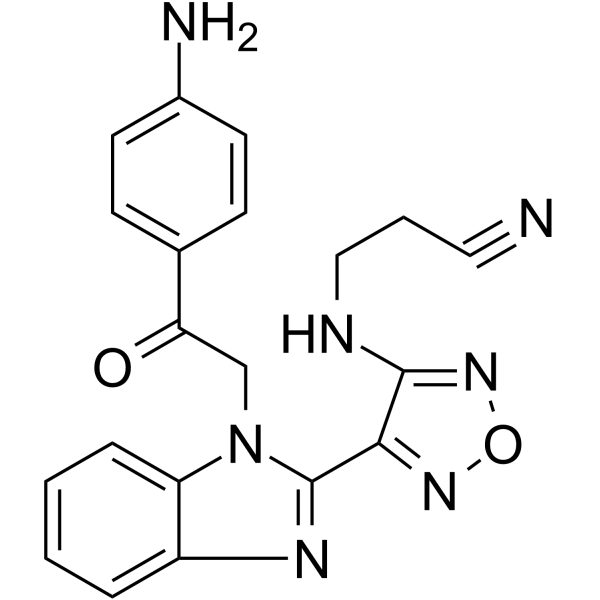Avanbulin (Synonyms: BAL27862) |
| Catalog No.GC63663 |
Avanbulin(BAL27862)은 강력한 콜히친 부위 결합 튜불린 조립 억제제입니다. Avanbulin은 37°C에서 1.4μM의 IC50으로 튜불린 조립을 억제합니다. Avanbulin은 244nM의 겉보기 Kd 값으로 tubulin에 결합합니다. Avanbulin은 암 및 세포 분열 연구에 사용할 수 있습니다.
Products are for research use only. Not for human use. We do not sell to patients.

Cas No.: 798577-91-0
Sample solution is provided at 25 µL, 10mM.
Avanbulin (BAL27862) is a potent, Colchicine site-binding, tubulin assembly inhibitor. Avanbulin inhibits tubulin assembly at 37 °C with an IC50 of 1.4 μM. Avanbulin binds to tubulin with an apparent Kd value of 244 nM. Avanbulin can be used for the research of cancer and cell division[1][2][3][4].
Avanbulin (0-4 μM) binds to tubulin with an apparent Kd value of 244 nM[1].Avanbulin (0-20 μM) and Colchicine (0-10 μM) are competitive for binding to tubulin with an apparent Ki value of 1.8 μM[1].Avanbulin binds to the same site as Colchicine at the intradimer interface[1].Avanbulin (50 μM; 0, 10, 20, 30, 60 min) induces the proteolysis of tubulin[1].Avanbulin (1-100 nM; 72 h; HeLa-tubGFP cells) has anti-proliferative effects[1].Avanbulin (33 nM; 0, 10, 20, 30, 60 min; HeLa-tubGFP cells) collapses the mitotic spindle and forms the tiny tubulin aggregates[1].Avanbulin does not induce the formation of tubulin oligomers[1].Avanbulin (0.1 nM-1.0 μM; 96 hours) induces growth inhibition of cells with a median relative IC50 of 13.8 nM[2].Avanbulin (0-1,000 nM; 3 days) inhibits the growth of glioblastoma cancer stem-like cells, GBM6 (EC50=20.8 nM) and GBM9 (EC50=21.7 nM) [3].Avanbulin (6 nM and 20 nM) inhibits the migration of GBM6 and GBM9 cells[3].Avanbulin (6 nM and 20 nM; GBM6-shEB1 and GBM6-sh0 cells) triggers astrocytic differentiation of GBM6 in an EB1-dependent manner[3].Avanbulin (12 nM; 4 h) reduces kinetochore-microtubule (KT-MT) occupancy of MG132(10 μM; 2h) treated hTert-RPE1 eGFP-α-tubulin cells[4].Avanbulin (12 nM; 4 h) reduces average inter-KT distances of cells[4].Avanbulin-treated (12 nM; 4 h) cells show intact spindle morphology and lack of obvious chromosome alignment defects[4].
[1]. Prota AE, et al. The novel microtubule-destabilizing drug avanbulin binds to the colchicine site of tubulin with distinct effects on microtubule organization. J Mol Biol. 2014 Apr 17;426(8):1848-60.
[2]. Kolb EA, et al. Initial testing (stage 1) of BAL101553, a novel tubulin binding agent, by the pediatric preclinical testing program. Pediatr Blood Cancer. 2015 Jun;62(6):1106-9.
[3]. BergÈs R, et al. The Novel Tubulin-Binding Checkpoint Activator BAL101553 Inhibits EB1-Dependent Migration and Invasion and Promotes Differentiation of Glioblastoma Stem-like Cells. Mol Cancer Ther. 2016 Nov;15(11):2740-2749.
[4]. Dudka D, et al. Complete microtubule-kinetochore occupancy favours the segregation of merotelic attachments. Nat Commun. 2018;9(1):2042. Published 2018 May 23.
Average Rating: 5 (Based on Reviews and 4 reference(s) in Google Scholar.)
GLPBIO products are for RESEARCH USE ONLY. Please make sure your review or question is research based.
Required fields are marked with *




















